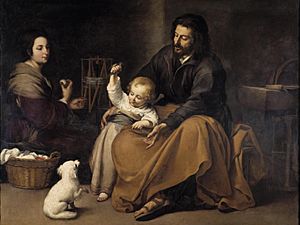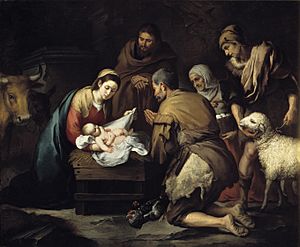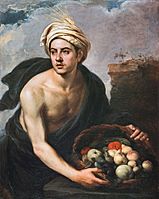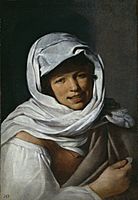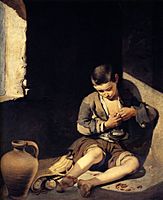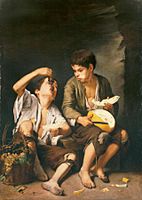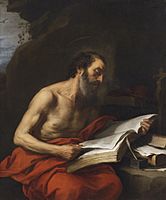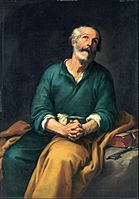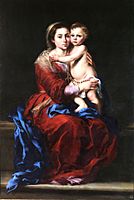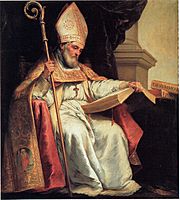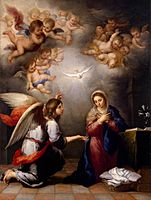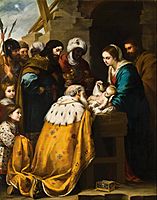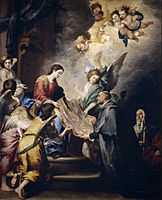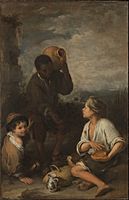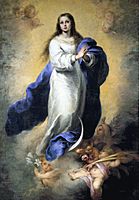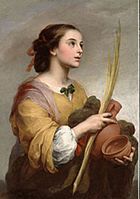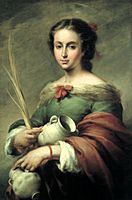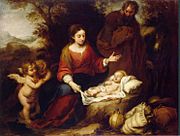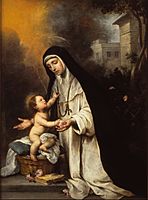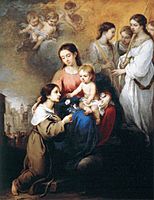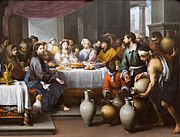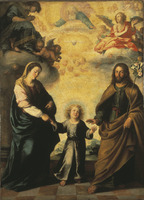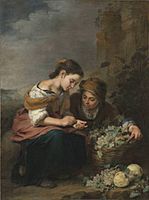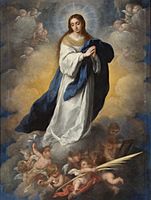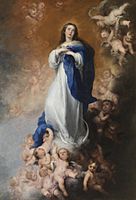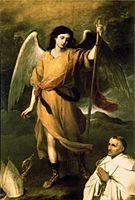Bartolomé Esteban Murillo facts for kids
Quick facts for kids
Bartolomé Esteban Murillo
|
|
|---|---|
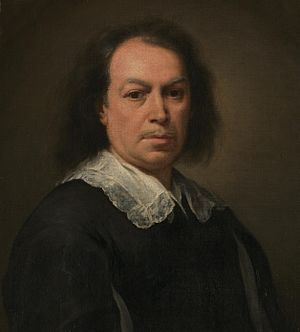
|
|
| Born | late December 1617; baptised January 1, 1618 |
| Died | April 3, 1682 (aged 64) Seville
|
| Nationality | Spanish |
| Known for | painting, drawing |
| Movement | Baroque |
Bartolomé Esteban Murillo (born in late 1617, baptized January 1, 1618 – died April 3, 1682) was a famous Spanish painter from the Baroque period. He is most famous for his religious paintings. But he also painted many pictures of everyday people, especially women and children. His lively paintings of flower sellers, street kids, and beggars show us what life was like in his time. Murillo painted two pictures of himself. One shows him in his 30s, and the other, painted about 20 years later, is in London.
Contents
Growing Up
Murillo was probably born in December 1617. His father, Gaspar Esteban, was a skilled barber-surgeon. His mother was María Pérez Murillo. He might have been born in Seville or in a smaller town called Pilas. We know for sure he was baptized in a church in Seville in 1618.
Sadly, both of Murillo's parents died when he was young, in 1627 and 1628. After that, his older sister Ana and her husband, Juan Agustín Lagares, took care of him. Juan was also a barber. Murillo stayed close to them and lived in their house until he got married in 1645. He often used his mother's family name, Murillo, instead of his father's.
Early Art Training
We don't have many records about Murillo's early life or how he started painting. When he was 15, in 1633, he got permission to travel to America with his family. He likely began his art career around this time or a little earlier.
Murillo started his art studies in Seville. He learned in the workshop of his uncle and godfather, Juan del Castillo. Castillo was a good painter known for his clear drawings and the loving expressions in his subjects. Murillo learned a lot from him. His first paintings were also influenced by other famous painters like Francisco de Zurbarán and Jusepe de Ribera. They all painted in a very realistic style.
Seville was a very important trading city back then. This meant Murillo was exposed to art from other places, like Flemish painting. As he grew as an artist, his paintings became more refined. This style was popular with wealthy people at the time, especially in his Catholic religious artworks.
Some people say Murillo left his uncle's workshop when he felt skilled enough. It's believed that in 1642, when he was 26, he traveled to Madrid. There, he might have seen the works of Diego Velázquez. The rich colors and soft shapes in his later paintings suggest he was influenced by these artists. However, there isn't much proof that Murillo actually went to Madrid. Some foreign historians even claimed he traveled to Italy, but Spanish historians said this was not true. They believed Murillo's success came from his hard work in Spain alone.
Instead, many believe Murillo became skilled by spending hours studying the world around him in his own room. He used these skills when painting for the public, for churches, and for other artists.
Career Highlights
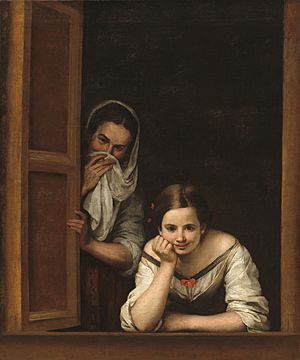
In 1645, Murillo returned to Seville and married Beatriz Cabrera y Villalobos. They had ten children, but only five lived longer than their mother. Only one son, Gabriel, became a painter like his father.
The year he got married, Murillo received his first big art job. He was asked to paint eleven large pictures for a church in Seville. He worked on these paintings from 1645 to 1648. These works showed different stories of saints that were not often painted. Murillo focused on showing lives of deep thought and prayer. His paintings from this time showed a mix of styles. Some were dark and dramatic, while others were soft and glowing. This glowing style became a key part of Murillo's later work.
For example, in a painting called Saint Diego Giving Alms, Murillo carefully placed people in layers against a dark background. In the middle, around a boiling pot, are children who seem to be bathed in a heavenly light. Murillo combined dark and light to show the beauty of helping those in need.
Around 1645, Murillo also finished one of his first paintings of children, The Young Beggar. In this painting, you can see the influence of Velázquez. After painting two pictures for the Seville Cathedral, Murillo started to focus on themes that made him very successful. These included paintings of the Virgin Mary and baby Jesus, and the Immaculate Conception.
Murillo spent another period in Madrid from 1658 to 1660. Then he returned to Seville. In 1660, he helped start the Academy of Art in Seville. This was a very busy time for him. He received many important jobs, including paintings for a monastery and for the Santa María la Blanca church.
Murillo died in Seville in 1682. This happened a few months after he fell from a scaffold while painting a fresco in a church in Cádiz.
His Legacy
Murillo had many students and people who followed his style. Because his paintings were copied so much, he became very famous in Spain and across Europe. Before the 1800s, more people knew about Murillo's art than any other Spanish artist. Other artists like Thomas Gainsborough were influenced by his style. In 2018, Google celebrated 400 years since Murillo's birth with a special drawing on their homepage.
Where to See His Art
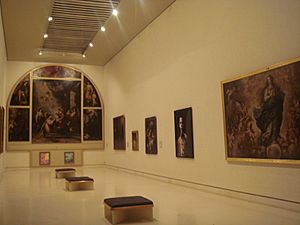
You can find Murillo's paintings in many famous museums around the world. Some of these include the Museo del Prado in Madrid, the Hermitage Museum in Russia, and the Wallace Collection in London. His painting “The Coronation in Heaven of the Mother of God” is in Kentucky, USA.
His painting Christ on the Cross is at the Timken Museum of Art in San Diego. Christ After the Flagellation is in Illinois. You can also see his work in museums in Oklahoma and Texas.
Selected Works
-
The Girl with a Coin or Girl of Galicia, c. 1645–1650, Museo del Prado
-
The Young Beggar, c. 1645, Musée du Louvre, Paris
-
St. Peter in Tears, c. 1650–1655, Bilbao Fine Arts Museum
-
St. Isidore of Sevilla, 1654, Cathedral of Seville, Spain
-
Annunciation, c. 1655–1660, Hermitage Museum, Moscow
-
Adoration of the Magi, c. 1660, Toledo Museum of Art
-
Apparition of the Virgin to St. Ildefonsus, c. 1660, Museo del Prado
-
Three Boys, c. 1660, Dulwich Picture Gallery
-
St. Justa, c. 1665, Meadows Museum
-
Rest on the Flight into Egypt, c. 1665, Hermitage Museum, Moscow
-
Christ Healing the Paralytic at the Pool of Bethesda, 1670, National Gallery, London
-
Saint Rose of Lima, c. 1670, Lazaro Galdiano Museum, Madrid
-
The Marriage Feast at Cana, c. 1672, The Barber Institute of Fine Arts, Birmingham
-
The Immaculate Conception of the Blessed Virgin Mary, 1678, Museo de Arte de Ponce
-
St. Raphael the Archangel with Bishop Domonte, c. 1680, Pushkin Museum, Moscow
See also
 In Spanish: Bartolomé Esteban Murillo para niños
In Spanish: Bartolomé Esteban Murillo para niños


